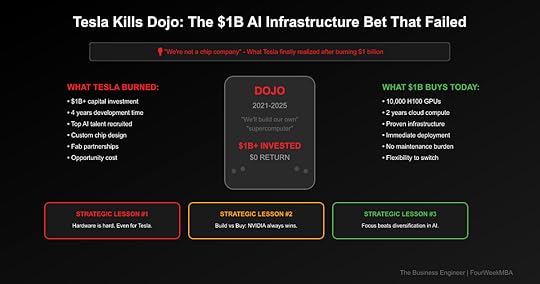Tesla Kills Dojo: Why Even Elon Musk Can’t Out-NVIDIA NVIDIA (And What Every CEO Should Learn From This $1B Mistake)

The Stunning Reversal: Tesla is disbanding its Dojo supercomputer team and unwinding one of Elon Musk’s most ambitious bets—building custom AI training infrastructure to rival NVIDIA. After burning over $1 billion and four years, Tesla just learned what every tech CEO needs to understand: in the AI infrastructure wars, there’s NVIDIA and there’s everyone else losing money.
The Dojo Dream That DiedWhat Tesla Tried to BuildIn 2021, Elon Musk announced Tesla would build Dojo, a custom supercomputer designed specifically for training autonomous driving AI. The pitch was compelling:
10x performance per dollar vs GPU clustersCustom silicon optimized for video processingVertical integration controlling the full stackCompetitive advantage through proprietary infrastructureThe reality in 2025:
Performance: Never matched NVIDIA’s pace of improvementCost: Over $1B invested with minimal returnTimeline: 4 years late and still not production-readyTeam: Disbanded, key talent departingThe Real Cost of “Not Invented Here” SyndromeWhat Tesla Actually SpentDirect Costs:
Chip design and development: ~$500MFabrication partnerships: ~$200MSoftware ecosystem: ~$150MTalent acquisition/retention: ~$100MInfrastructure and facilities: ~$100MTotal Direct Investment: >$1BHidden Costs:
4 years of development timeDistraction from core FSD improvementTalent that could have worked on AI applicationsBoard/investor confidenceCompetitive positioning vs companies using NVIDIAWhat $1B Buys in 2025Option A: Build Your Own (Tesla’s Choice)
Maybe a working prototypeEndless maintenance burdenObsolete before deploymentZero ecosystem supportRecruitment nightmareOption B: Buy from NVIDIA
10,000 H100 GPUs delivered tomorrow2-3 years of cloud computeContinuous upgradesFull software stackImmediate productivityWhy Tesla Failed Where Others Might SucceedThe Unique Challenges Tesla FacedMoving Target Problem– NVIDIA improving 2x annually
– Dojo improving… eventually
– Gap widening, not closing
– NVIDIA: Millions of developers
– Dojo: Dozens of internal users
– No third-party support
– Hardware is 20% of the problem
– Software, tools, optimization: 80%
– Tesla underestimated the 80%
– Every Dojo engineer not working on FSD
– Every dollar not buying proven compute
– Every month waiting for Dojo vs shipping features
Tesla’s Core Competencies:
Electric vehiclesBattery technologyManufacturing at scaleSoftware (arguable)Not Core Competencies:
Chip designSemiconductor fabricationLow-level systems softwareCompeting with NVIDIAThe Test: If NVIDIA’s existence threatens your strategy, your strategy is wrong.
Lesson 2: Build vs Buy in the AI EraBuild When:
It’s core to your differentiationNo adequate solution existsYou have unique requirementsTime isn’t criticalYou can attract the talentBuy When:
Good solutions exist (NVIDIA)It’s not your core businessSpeed mattersEcosystem mattersMaintenance isn’t your strengthTesla violated every “Buy” indicator.
Lesson 3: The Vertical Integration TrapWhen Vertical Integration Works:
Significant cost advantages (30%+)Unique performance requirementsSupply chain control criticalLong product lifecyclesWhen It Fails:
Rapid technology evolutionComplex ecosystems requiredSpecialized expertise neededFast-moving competitorsAI infrastructure checks every failure box.
What This Means for Other CompaniesFor Automotive CEOsThe Message: You’re not a chip company. Tesla couldn’t do it with unlimited capital and top talent. Neither can you.
The Strategy:
Partner with NVIDIA/AMD/IntelFocus on AI applications, not infrastructureBuild competitive advantage in data and algorithmsLet specialists handle the siliconFor Tech CEOsThe Warning: Even if you have chip expertise, ask why.
Key Questions:
Is this 10x better than buying?Can we maintain competitive parity?What’s the opportunity cost?Where’s our real differentiation?For InvestorsRed Flags:
“We’re building custom chips for AI”“Vertical integration” without clear advantageInfrastructure investments in non-core areasNIH syndrome in leadershipGreen Flags:
Clear build vs buy frameworkPartnership with proven providersFocus on application differentiationCapital efficiencyThe Broader ImplicationsThe NVIDIA Monopoly StrengthensTesla’s retreat reinforces NVIDIA’s position:
Message to market: Resistance is futilePricing power: Even strongerInnovation pace: No pressure to slowEcosystem moat: Deeper than everThe New AI Infrastructure RealityWinners: Companies that accept NVIDIA’s dominance and build on top
Losers: Companies trying to rebuild the foundation
Smart Players: Those finding differentiation in applications, not infrastructure
– Move chip designers to FSD algorithm team
– Systems engineers to deployment optimization
– Infrastructure team to application scaling
– Negotiate volume deals
– Get early access to new chips
– Influence roadmap as major customer
– FSD algorithm superiority
– Data collection advantage
– Real-world deployment experience
– Integration with vehicle systems
Double Down on What Works:
World’s largest autonomous driving datasetMillions of cars collecting dataVertical integration in manufacturingSoftware update infrastructureStop Fighting Unwinnable Wars:
Custom training chipsCompeting with NVIDIAInfrastructure nationalismNot-invented-here syndromeThe Bottom LineTesla’s Dojo shutdown isn’t just a failed project—it’s a $1 billion case study in strategic overreach. Even with Elon Musk’s vision, Tesla’s capital, and some of the world’s best engineers, they couldn’t out-NVIDIA NVIDIA. The lesson is clear: in the AI era, knowing what NOT to build is as important as knowing what to build.
For Tesla, killing Dojo might be the smartest strategic decision they’ve made in years. It frees up resources, refocuses the company, and acknowledges reality. For everyone else, it’s a warning: stick to your strengths, buy the infrastructure, and compete where you can actually win.
The Ultimate Irony: Tesla’s FSD might finally achieve full autonomy now that they’ve stopped trying to reinvent the wheels it runs on.
Three Strategic Takeaways:Infrastructure is a means, not an end: Focus on what you’re building, not the toolsOpportunity cost is real cost: Every dollar spent on infrastructure is a dollar not spent on differentiationPartner with the leaders: In AI infrastructure, that means NVIDIA whether you like it or notStrategic Analysis Framework Applied
The Business Engineer | FourWeekMBA
The post Tesla Kills Dojo: Why Even Elon Musk Can’t Out-NVIDIA NVIDIA (And What Every CEO Should Learn From This $1B Mistake) appeared first on FourWeekMBA.



